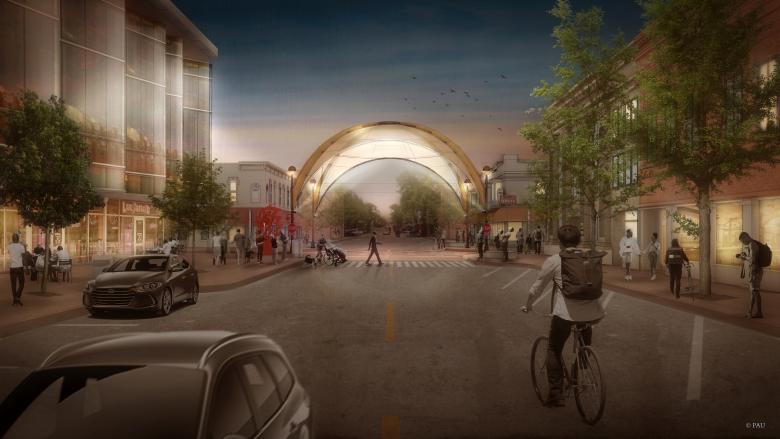Exhibit Columbus Unveils 'Public by Design' Installations
The designers of the installations that will fill the streets and parks of Columbus, Indiana, later in the year, unveiled their designs during presentations at a public forum on February 25.
The presentations were the second component of the three events that comprise each biennial Exhibit Columbus: It followed the 2022 Exhibit Columbus Symposium that took place last October and is an important step toward the 2023 Exhibit Columbus Exhibition opening to the public on August 26 under the theme Public by Design. Last week's presentations gave the few hundred onlookers a chance to see the designs but also to provide feedback that will help shape the installations between now and August.
Key among the 13 installations are the four recipients of the J. Irwin and Xenia S. Miller Prize, named for the husband-and-wife patrons who “helped bring twentieth-century architectural masterpieces to Columbus through public-private coalitions.” The four installations are illustrated below, with text descriptions courtesy of the designers and Exhibit Columbus.
“How can we allow for the possibility of public space to become a platform for collective and social exchange, where everyone can perform their own idea of inhabitation? That is the question guiding our intervention at the Library Plaza, following this year’s curatorial theme. We call for the use of the space to be designed by the public!
“By limiting our role to providing the tools for people to express their desires and intentions on this important site, our installation becomes an ongoing participatory process. This was done through design workshops with members of the community, a team effort with the library to bring their social programs outdoors, and an invitation to the broader community to engage in a process of environmentally friendly production. The installation encourages visitors to freely use a broad collection of objects, furniture, and equipment to build to their own ideas, to allow for all possibilities, and to embrace the unexpected.”
“Interoculus is proposed to be built at the crossroads of Indiana’s Columbus: at the intersection of Washington and Fourth Streets. Its canopy form, celebratory purpose, and equitable invitation are derived from an extensive community engagement process and inspired by influences as diverse as the iconic Pantheon in Rome, local carnival vernacular, ice cream sundaes from Zaharakos, and the wigwams of the Miami and Shawnee peoples. By recycling the intersection’s existing street poles and piggybacking on their infrastructure, the design seeks to create an egalitarian visual and physical destination that revitalizes downtown day and night through the experiences of suspension, projection, and illumination. The project asks the community to inhabit the structure, revel in the city’s historic downtown, and advocate for permanent urban public space that connects the diverse communities and mindsets of Columbus through positive social friction.”
“THE PLOT PROJECT interfaces the Mill Race [Senior] Center with its surrounding landscapes in order to place the Center’s diverse activities and the latent biodiversity potential of its surroundings emphatically into public dialogue.
“By extending and inscribing the shape of the Center into the landscape, we define an arc approximately 1250’ in length, covering just under 1.5 acres of ground.
“This zone is subdivided into 12 plots that serve as parcels for landscape rewilding experiments that will take place over the course of a 9-month growing season. Some plots are left to go feral while others are intentionally prepped and overseeded with mixes of warm-season native grasses.
“As a means of delineating between each of the 12 plots, 6’ wide bands of annual wildflowers are planted on the radii of the arc.
“Along the inside curve, survey poles are arrayed at 25’ intervals allowing the arc geometry to be legible from the ground. A narrow gravel path runs along the poles.
“At three points along the arc, over-scaled seating structures are positioned as anchors. Riffing on the mid-century architectural heritage and color palette of Columbus, the pavilions invite individual reflection and social interaction.”
“For the 30th anniversary of the Mill Race Park, Studio Zewde is exploring the deep history of the site—from indigenous landscape technologies to localized histories like the River Rats and the Mill Race Monster. Research into the community’s favorite stories and spots, and imagined futures for the place, to identify a strong relationship to landmarks such as the hill, the pond, the trails, and the follies. This installation engages the interface between one of these beloved landmarks—the hill—and one of these spaces of opportunity—Festival Field. In the dedication ceremony 30 years ago, Michael Van Valkenburgh made explicit reference to the hill’s form echoing the ancient mound-building traditions from this area. This installation seeks to amplify this echo with a series of red frames mirroring the existing hill. This effect makes the mound’s circle complete, suggesting a civic center for gathering. Moreover, as a hollow form, the interior of the installation can be activated by events or everyday life, while offering a festive backdrop to the open lawn. The installation presents a literal and metaphorical 'frame' on the pasts, presents, and futures of this land while invoking its future possibilities.”
In addition to the four Miller Prize installations pictured here, the 2023 iteration of the Exhibit Columbus Exhibition, when it opens to the public on August 26, will have contributions by seven University Design Research Fellows. Their projects follow the recommendations of a two-year-old Downtown Activation Study aimed at activating the historic core of downtown Columbus. The seven fellows:
- Carousel for Columbus by Joseph Altshuler and Zack Morrison
- Ground Rules by Jessica Colangelo and Charles Sharpless
- PIPE UP! by Halina Steiner, Tameka Baba, Forbes Lipschitz, and Shelby Doyle
- PRISMA by Esteban Garcia Bravo and Maria Clara Morales
- RECORDAR by Deborah Garcia
- Side Effects by Molly Hunker and Greg Corso
- Sylvan Scrapple by Katie MacDonald and Kyle Schumann
Lastly, Exhibit Columbus features 街 Machi, an installation by the High School Design Team, and a visual graphic and wayfinding system, Signals, developed by Chris Grimley.





